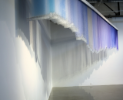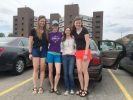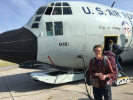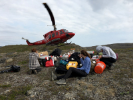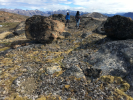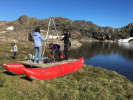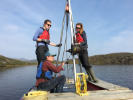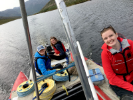UB scientists’ travel companion in Greenland? Artist Anna McKee

Artist Anna McKee at work in Greenland, where she made pencil drawings and watercolor paintings while observing climate scientists taking samples on a UB-led research expedition. The sketches McKee completed in Greenland will serve as the basis for future, finished works of art that could include more detailed drawings, etchings and a sculpture. Credit: Elizabeth Thomas
Together this summer in the Arctic, the researchers and their guest shared a common goal: telling the story of a changing planet
Release Date: September 5, 2018 This content is archived.
BUFFALO, N.Y. — In the morning, under a big Arctic sky, in a wild part of the world with no paved roads or electric lines, University at Buffalo geologist Elizabeth Thomas would board a small pontoon and motor out onto a lake.
Beside her, on a typical day, would be a team of three UB geology students: undergraduate Kayla Hollister; master’s student Meg Corcoran; and PhD student Allison Cluett.
They carried with them the instruments of science: Work gloves. Waterproof boots. Glass vials. Spools of heavy-duty cording. Bright-white PVC tubes, which are used to collect cylindrical samples of lakebed mud whose ancient layers hold clues about a region’s prehistoric temperature and precipitation.
The researchers would focus intently on their work. Then, they would return to shore to be greeted by Anna McKee, a Seattle-based visual artist armed with an arsenal of her own tools: pencils, cotton rag paper and a small kit of watercolors.
“She would sit and draw us on the lake as we were working, and it would be this beautiful sketch of the lake, and we would be like this” — Thomas holds up two fingers to indicate a space smaller than the surface of a dime.

The research team assembles their pontoon boat on the shore of an isolated lake in Greenland. Credit: Anna McKee
“Having Anna there, she looks at the world with a totally different mindset than I do as a scientist,” says Thomas, PhD, a climate researcher and assistant professor of geology in the UB College of Arts and Sciences. “When I look at the landscape, I see definitions: U-shaped valley. Kame terrace. Here’s where a glacier was, and it was this long ago, and then the plants came. It’s not like everything is labeled — but it’s almost like that.
Artist Anna McKee (second from left in back, in purple) joined a UB-led research trip to Greenland in July 2018. The Arctic expedition was headed by Elizabeth Thomas, UB assistant professor of geology (far left). Others on the trip included UB students Kayla Hollister (front), Meg Corcoran (back, in red) and Allison Cluett (back, next to Corcoran); and Margie Turrin, education coordinator for Columbia University’s Lamont-Doherty Earth Observatory (far right). Credit: Elizabeth Thomas
“And Anna just sees the beautiful shapes. Having her with us really enhanced the experience in the moment.”
McKee joined Thomas’ team in Greenland for 12 days this July to observe the scientists at work in a remote wilderness. The expedition — including McKee’s visit — was funded by the National Science Foundation (NSF). The artist and researchers’ shared objective on this journey? To tell the story of Earth’s environmental past and how the planet may change as it warms.
Lonely landscapes filled with meaning
This is how McKee explains her work on her website:
“My art is an exploration of memories that accumulate in the physical world, specifically where human history intersects a longer time span.”
“I draw to explore ideas about land and how it is altered through time.”
Climate science ties into these themes. McKee is fascinated by the way information about the Earth’s history is stored in landscapes — in geologic formations carved by retreating glaciers; or in ice sheets formed from thin layers of snow that, deposited year after year, can be read by scientists to discern how the planet’s climate has changed over the millennia.
In 2009-10, McKee joined researchers in Antarctica as they drilled two miles into the ice to retrieve samples of frozen water containing the chemical signature of ancient temperature fluctuations. Her sketches and observations led to “WAIS Reliquary: 68,000 Years,” a multimedia sculptural installation, including 3,405 samples of water from the ice core the scientists collected, organized to represent 68,000 years of climate history. Other finished works included paintings of the landscape and haunting etchings of the camp — an isolated human presence on a seemingly endless expanse of white.
"WAIS Reliquary: 68,000 Years" by Anna McKee. Click on photos above for captions and credits.
“I was struck by how much seemed familiar in a landscape that was so foreign,” McKee writes on her website. “There was a machine shop to repair the ice drill, and domestic comforts like laundry, showers and a commercial kitchen. But there were also ice crystals floating in the air creating fantastic optical effects. The ever-present wind daily swept away the snow groomer’s efforts to keep a clear skiway for flights.”
McKee’s visit to Greenland, observing UB researchers and the landscape they are studying, intends to build on this work.
Field camp, through an artist’s eyes
The average morning at an Arctic field research camp goes like this:
Get up. Convene in the kitchen tent. Pour yourself a cup of coffee, and eat a breakfast of dried fruit and oatmeal and maple syrup and nuts. Call the NSF’s polar services contractor to check in at 7:45: Yes, we are OK.
Then it’s time to gear up and head out.
UB undergraduate student Kayla Hollister collects a sample of rock from Greenland. The chemical content of such boulder samples can provide clues about when glaciers may have disappeared in a region. Credit: Elizabeth Thomas
“When I’m in the field, my main goal is to sit and draw, and that’s how I get a lot of material for work that I do later,” McKee says, recounting her average day in Greenland. “It’s my version of taking samples or field notes. And that was very much weather-dependent, so when the weather was cooperative, I would set up to draw, and when it was raining or too windy, I would watch what they were doing, go on the hikes with them or help gather samples and carry gear.”
UB PhD student Allison Cluett holds a plant sample taken in Greenland. Plants hold information about a region’s precipitation patterns. Credit: Elizabeth Thomas
From her sketches, photographs and notes, McKee has begun to formulate an idea of future works she will complete to capture the story of the science that Thomas and colleagues are doing.
Thomas, Hollister, Corcoran and Cluett are part of a larger, multi-institutional team led by UB geology professor Jason Briner, PhD. Their research, the $2.9 million Snow on Ice project, explores how warmer temperatures and changes in Arctic precipitation could affect the Greenland Ice Sheet — the second-largest body of ice on Earth — and influence global sea level rise. In addition to UB students, the summer trip Thomas organized included Margie Turrin, education coordinator for Columbia University’s Lamont-Doherty Earth Observatory, a partner on the science.
McKee plans to start her work with a series of landscape drawings and a suite of etchings. She’d also like to gather leftover materials from the research — maybe silt or lake water or tiny pieces of broken rock, depending on what samples are available — to create another sculptural reliquary.
Artist Anna McKee in Greenland, completing a rubbing of an Arctic plant. Toward the end of the trip, McKee showed the scientists how to make their own rubbings — souvenirs from a productive research expedition. Credit: Eliabeth Thomas
Having an artist as a travel companion didn’t slow down the pace of life in Greenland; field research is expensive, so Thomas and her team worked to make every minute count. But McKee’s presence invited the scientists to see their surroundings in a new light, says Thomas, who has traveled to Greenland for research four times.
“It was so much fun to have Anna with us. She drew these beautiful landscapes that we were in, and it was so interesting, because we got to see it through her eyes. It wasn’t just a photograph — this was her impression of the landscape. And the details were amazing.
“The art that Anna is creating is another way to reach out to a broader audience about the science. It’s really a wonderful way to make our work more accessible.”
McKee says that in the end, the job of the artist and scientist intersect. The tools are different, but the mission is, in some ways, the same: “We’re both looking at the world to understand it and find a language to communicate our observations. We’re interpreting what we see and bringing it into the world to share it with other people.”
Media Contact Information
Charlotte Hsu is a former staff writer in University Communications. To contact UB's media relations staff, email ub-news@buffalo.edu or visit our list of current university media contacts.











